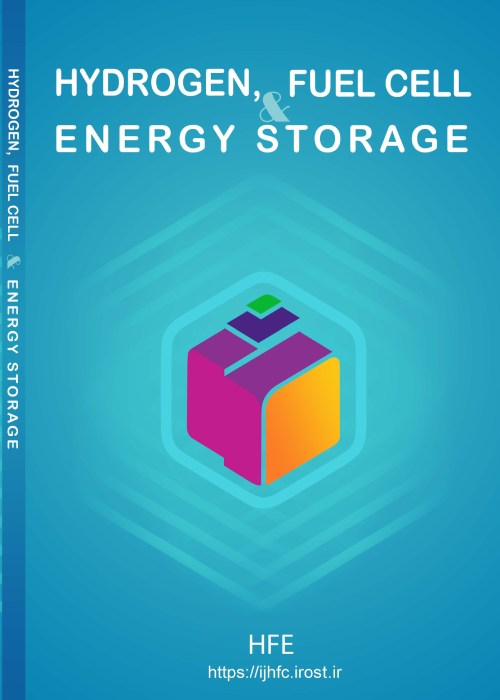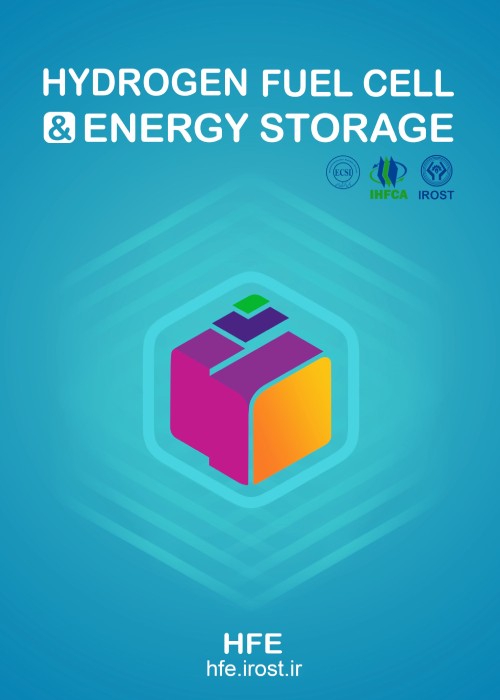فهرست مطالب

Journal of Hydrogen, Fuel Cell and Energy Storage
Volume:10 Issue: 1, Winter 2023
- تاریخ انتشار: 1402/01/12
- تعداد عناوین: 6
-
-
Pages 1-10Proton ion conducting nano crystalline yttrium doped barium cerate (YBCO) is synthesized by ethylene glycol and citric acid assisted sol–gel method. In this paper two different kinds of BaCe 0.9Y0.1O 3-a nano composites were prepared. YBCO (I) have been synthesized by [(Ce2(pydc)4(H2O)4].pyda.H]2.2H2O, {[Ba1.5 (pydc.H) (pydc) (H2O) ]. H2O. 0.5 (pydc.H2)}n, [(Y2 (pydc)4 (H2O)4].pyda.H]2.2H2O]], [pydc (2,6-Pyridinedicarboxylic acid), pyda (2,6-diaminopyridine)] and YBCO (II) was synthesized by by (Y(NO3)2.6H2O, Ba(NO3)2, Ce(NO3).6H2O). The powders of (I) and (II) was calcined for a period of 8 hours at 900 °C to get the fine yttrium doped barium cerate powders and the specifications were compared. Various analytical techniques have been used for characterization of the samples, such as scanning electron microscope (SEM), Energy-Dispersive X-ray Spectroscopy (EDS), thermal analysis TG/DTA and X-ray powder diffraction (XRD) used. The results showed that the powders synthesized by metal complexes containing LH2 ligand as precursors, were denser, more homogeneous with smaller particle sizes. The experimental results showed YBCO (I) effectively improve the electrochemical performance of the electrolyte.Keywords: Solid oxide fuel cell, Photonics conducting membrane, Yttrium doped barium cerate, Soft chemistry method
-
Pages 11-32Many industrial processes have low temperature heat losses and are generally ignored due to the lack of effective heat recovery methods. Ignoring these heat sources can cause heat pollution and damage to the environment. Using the low-temperature organic Rankine cycle (ORC) is a good solution to this problem. The main target of this research is to model and analyze the performance of two hybrid systems, gas turbine (GT), steam Turbine (ST) and solid oxide fuel cell (SOFC) with the hybrid GT, ORC and SOFC cycle (SOFC+ GT+ ORC) from the thermodynamic and exergy perspectives. Studies show that the output power of a combined system with a steam cycle is higher than that of a system with an organic Rankine cycle, but this higher output does not necessarily mean that this cycle is better. The use of a steam cycle at a higher power range and higher temperature of the inlet gases of turbine is more justified. The results show that the use of toluene fluid in the organic Rankine cycle among the analyzed fluids produces the most power at the condenser temperature of 319 Kelvin.Keywords: organic Rankine cycle, Solid oxide fuel cell, Gas turbine, Exergy, Combined cycle
-
Pages 33-50Improving the subsea endurance and the power system efficiency of unmanned underwater vehicles (UUVs) has become more important in recent years as their growing demands in different applications. Integrated electric power systems are commonly applied in UUVs with different types of batteries as power sources. Utilizing fuel cells hybridized with batteries is one of the most efficient ways to increase the UUV's range and overall system efficiency. In this paper, a conceptual design is presented for fuel cell/battery hybrid UUV. To elaborate on the design process, the UUV fuel cell stacks, the commercial fuel cell UUVs, the technologies of the fuel and oxidant storage, and the electrical energy storage subsystems are reviewed. Also, analytical investigations have been presented on the degree of hybridization (DOH) between fuel cells and batteries. The fuel cell/battery hybrid system for UUV is designed and the technologies of its main components are proposed as the final step of the conceptual design process.Keywords: Unmanned Underwater Vehicles, Hybrid, fuel cell, Battery
-
Pages 51-67In this study, a novel multigeneration cycle including PTC and geothermal as the main energy sources and Kalina and ORC cycles as the main power production cycles have been proposed and analyzed from energy and exergy point of view. The effect of important parameters including solar irradiation, collector inlet temperature, collector volumetric flow, environment temperature, and geothermal temperature on the amount of the hydrogen production rate, freshwater production rate, and system efficiency have been investigated. The results show that the energy and exergy efficiency of the proposed system is 35.75 % and 18.39 %, respectively. Moreover, the total power produced by the system is obtained to be 1545 kW, the amount of hydrogen produced is 0.001175 g/s and the freshwater production rate is 5.216 kg/s. Furthermore, the results indicated that increasing geothermal temperature and solar collector inlet volumetric flow, increase hydrogen production rate and solar irradiation and environment temperature have no effects on the hydrogen production rate of the cycle. Finally, it is found that geothermal temperature increase and collector volumetric flow show an optimum point for thermal efficiency and freshwater, respectively.Keywords: Energy, exergy analysis, PTC, geothermal, PEM electrolyzer, Hydrogen production
-
Study of Contact Pressure Distribution over MEA of the Three-Cell PEMFC with Metallic Bipolar PlatesPages 69-79One of the parameters that play an important role in the efficiency of polymer electrolyte membrane fuel cells (PEMFCs) is the contact pressure between the bipolar plates and membrane electrode assembly (MEA). Increasing or decreasing the contact pressure between the plates causes ohmic losses and decreases the efficiency of the fuel cell. In this research, the contact pressure distribution over the MEA in the three-cell fuel cell stack with metallic bipolar plates with an active area of 100 cm2 was investigated numerically and experimentally. Abaqus finite element software has been used for finite element simulation. Due to the asymmetry of the flow field of metallic bipolar plates, a full three-dimensional model has been used for simulation. In order to experimentally investigate the contact pressure distribution on the MEA, the pressure sensitive film of Fujifilm was used. Considering that the fuel cell stack includes three cells, pressure sensitive film is used in the middle cell and thin insulating plates are used in the first and third cells. Finally, after disassembling the fuel cell stack and separating the pressure sensitive film, the experimental test results are compared with the simulation results. The simulation results showed that the pressure changes on the active area are less than 0.3 MPa. The average contact pressure on the active area with a press force of 3.7 tons is about 1 MPa. Also, the results of the experimental tests were in good agreement with the simulation results.Keywords: PEMFC stack, Contact pressure distribution, metallic bipolar plates, pressure sensitive film
-
Pages 81-93In the present study, the lubricated and non-lubricated stamping processes are used for fabrication of the metallic bipolar plates (MBPPs) with a thickness of 0.1 mm made of SS3316 with a serpentine flow field. Experimental tests together with the finite element (FE) model are utilized to define the directional thickness distribution. According to the results, considering the friction factor of 0.1 during the FE analysis is capable of providing accurate results in terms of thickness prediction under lubricated conditions. The largest thinning percentages in the modified conditions are found to be 27.02%, 30.40%, and 26.00% in the longitudinal, diagonal, and transverse directions, respectively, indicating that the diagonal direction is the most critical one. Finally, the effect of lubricating condition on wrinkling of the sample is investigated. According to the results, using the lubricated condition during the stamping process would lead to augmentation of the wrinkling of the bipolar plate and also, the wrinkling of bipolar plate’s margin was not symmetrical.Keywords: PEMFC, metallic bipolar plates, Metal forming, sheet metal


